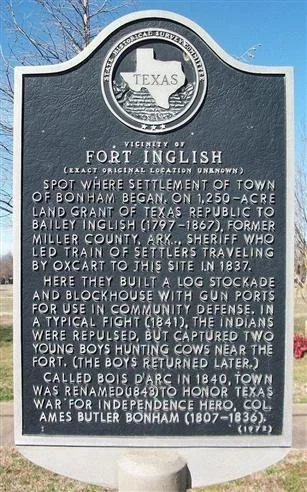Fort Inglish (vicinity of)
Marker Text:
Spot where settlement of town of Bonham began, on 1,250-acre land grant of Texas Republic to Bailey Inglish (1797-1867), former Miller County, Ark., Sheriff who led train of settlers traveling by oxcart to this site in 1837.
Here they built a log stockade and blockhouse with gun ports for use in community defense. In a typical fight (1841), the Indians were repulsed, but captured two young boys hunting cows near the fort. (the boys returned later.)
Called Bois d'Arc in 1840, town was renamed (1843) to honor Texas War for Independence hero, Col. Ames Butler Bonham (1807-1836).
Location: near the corner of Lipscomb and 9th Street, Bonham
In 1976 the fort structure was moved to the area that is now just west of the Rayburn Library, and other pioneer buildings have been added to Fort Inglish Village.
Bonham Daily Favorite, Thursday, November 22, 1934
Geo. L. Inglish of Stamford
Writes an Interesting Letter
About Old Fort Inglish
For several weeks the Favorite has been seeking some definite information about old Fort Inglish with a view to reestablishing the fort in some way and make it an attractive place for tourists who will come to Texas for the Centennial in 1936.
The following letter from George Inglish, formerly of Bonham, but now editor of the Stamford Leader, contains interesting information regarding the fort:
Stamford, Texas, Nov. 19, 1934, Eds. Daily Favorite, Bonham, Texas,
Dear Sirs:
I note in your Saturday issue where you wish letters from those who know anything about Fort Inglish, which was built by Bailey Inglish in the year of 1838, perhaps it was finished in 1839.
Fort Inglish was what was called a block house. It was build at the earnest request of neighbor and friends of Bailey Inglish, my grandfather, he having been asked repeatedly to build it. It was intended for the people to gather there in times in Indian uprisings. Let us say right here that Indians never went on raids in rainy weather, cold weather nor the dark of the moon, so there were periods when the early settlers rested in peace. The Indians picked moonlight nights for two reasons, which were: They figured that the white man could not see well on moonlight nights, and they also figured they could see about as well on moonlight nights as they could when the sun was shining, and in that they were nearly correct, about as correct as they were in reckoning about the Whites. It seemed that Bailey Inglish feared the Indians very little, as he was kindly toward them. But his neighbors wanted the Fort, so he built it.
If you wish a very fair likeness of the Fort, go down to the Inglish cemetery and you will find it on Bailey Inglish's tombstone - mule team, prairie schooner and all, with the Fort in palisades behind it. The man who knew about what the Fort looked like told me to get a copy of a picture of Fort Dearborn, built in Chicago in 1832 and I would have it. I did, and what you see on that stone is a copy of the Dearborn Fort. I saw an exact reproduction of Fort Dearborn at Chicago at the Century of Progress last year and I am sure Mr. Fox, who did the sculpture on the tombstone, followed out the Dearborn plan. Mr. Fox was really an artist who worked for the Anderson's there in the Marble Works. The Anderson's not only gave me a special price on the tombstone, but also donated money on the same. They spent much work on the stone, saying they were interested. It is stated that stone would have cost easily double what we paid for it, had they received its worth. We paid $100 for it. Ashley Evans can tell you something about it. He gave $5 for the Bonham News on that stone, and that with the Anderson donation was the only outside money paid, the family of Bailey Inglish doing the rest.
The Fort was located about two hundred yards southwest of Smith Lipscomb's home, which was the old Inglish home place. It was near the northwest corner of the Lipscomb field. Either Chas. or Percy Inglish can show you the exact spot.
Bailey Inglish kept open house, never charging a cent for board or room.
Many came who did not pay, and many of them never told their names. It was neither healthful nor wise to ask them, either. The Younger Brothers, the most fearless and daring men of all time in the United States, according to no other personage than Jesse James himself, he saying repeatedly that Cole Younger was the most dangerous man he ever saw and he was actually afraid of no other man on earth except Cole. Cole Younger told me no less than three different times, after he was liberated from his life term in Stillwater, Minn., penitentiary, for the robbery of the Northfield, Minn., bank, which was a failure, that he
stopped at the Bailey Inglish home before and after the Civil War. The James Brothers were there, Frank and Jesse, but they left the fight in the woods for their own safety and told Cole Younger to do so, too. Younger said, "no, I have one brother killed there by the posse and another perhaps fatally wounded. I'll stay with them till the last. Perhaps the James Brothers stopped at my grandfather's house. I almost know some of the Quantrel gang did. If this is worth anything, use it.

